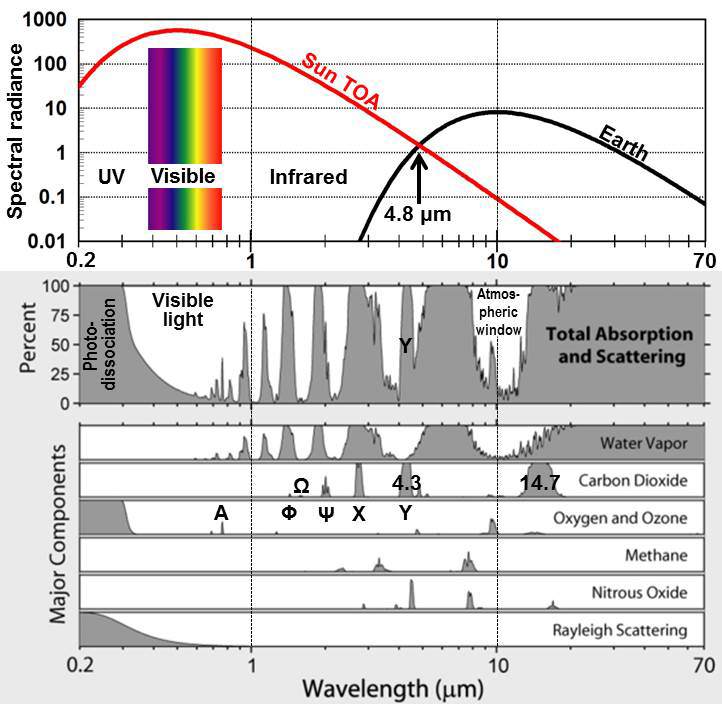Absorption Bands for Solar and Terrestrial Radiation

Greenhouse gases absorb radiant energy only in very narrow bands of wavelength. The red line shows the amount of radiation (spectral radiance) from the Sun received at the top of Earth’s atmosphere (TOA) based on Planck’s law assuming a solar temperature of 5770K (Harder et al., 2009). The black line shows the spectral radiance emitted by Earth assuming a terrestrial temperature of 288K. Note the very low atmospheric absorption for the wavelengths of visible light (0.38 to 0.75 μm) where most solar energy reaches Earth and in the atmospheric window around 10 μm (micrometers) through which most infrared energy from Earth reaches space.
The peak spectral radiance to reach the top of Earth’s atmosphere is 568 watts per square meter per steradian per cycle per second corrected for spreading of the rays by multiplying Sun’s peak spectral radiance times the square of Sun’s radius divided by the square of the distance from the center of Sun to Earth. When integrated across the appropriate solid angle and all frequencies, this value was observed recently to be between 1361 and 1362 W m-2 (ACRIM, 2013).
The peak spectral radiance of infrared energy radiated by Earth is only 1.4% of the peak spectral radiance of solar radiation at the top of the atmosphere (69 times smaller). The spectral radiance of infrared wavelengths reaching the atmospheric window (around 10 μm) from the sun is 90 times less that the spectral radiance from Earth.
Absorption and scattering bands are from Rohde (2013). “A” designates the Fraunhofer line of absorption at 0.759 μm, just above the visible spectrum. Φ, Ω, Ψ, X, and Y are absorption bands identified by (Langley, 1888). The absorption band at 14.7 μm was identified by (Rubens and Aschkinass, 1898, pdf). Note that terrestrial infrared spectral radiance is trivial at Φ, Ω, and Ψ. At X it is 1775 times smaller than at 10 μm and at Y it is 11 times smaller than at 10 μm. The only absorption bands of carbon dioxide that absorb perceptible radiant energy are at Y (4.3 μm) and 14.7 μm. (Current data from Hitran put this peak near 15 μm (Rothman et al., 2013).) Around 14.7 μm, mean existing concentrations of water vapor and carbon dioxide appear to absorb essentially all available terrestrial radiation but this may vary since the amount of water vapor can vary from 0.001% to 5% by volume. In any case, the amount of radiant energy that can be absorbed by a doubling of carbon dioxide concentrations appears to be very small.
What we think of as Rayleigh scattering is largely photodissociation of oxygen (O2) and ozone (O3) caused by high-energy ultraviolet solar radiation. Photodissociation is a particularly effective way to turn radiant energy into temperature of a gas and temperature is proportional to the amount of energy involved. Max Planck postulated (Planck postulate) that the energy of electromagnetic radiation is equal to the Planck constant times the frequency. The energy of ultraviolet radiation at 0.310 μm (4.0 eV, electronvolts), energetic enough to photodissociate ozone, is 48 times the energy contained in infrared radiation at 15 μm (0.083 eV), near the center of the broadest absorption peak for carbon dioxide (CO2). There is far less energy available to be converted to temperature in the infrared than in the ultraviolet and conversion in the ultraviolet is far more efficient.